Alien, real versions
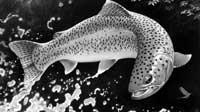
Any ecosystem is based on a complex and fragile balance. If the population of hares increases, for example, the wolves that feed on them will also increase, due to the increase in food. But when the hare population begins to decrease, the wolf population also goes down quickly, as they will not have food. If man kills the wolves and the species becomes extinct, the hares will not have predators around and the population will increase spectacularly. This occurs when a certain species is placed in an ecosystem without predators, as is the case with invasive species.
The predators or control mechanisms that keep their population stable over time correspond to each living. Problems arise when an organism is driven to a strange ecosystem that does not have these control mechanisms. It may happen that the foreign organism does not adapt well to the new ecosystem and adapts without it disappearing or producing large imbalances, but it is also common that the opposite occurs, without any control and easily.
Versatile Beings

Biological invaders are usually fast-growing species with short reproductive cycles. At the same time, they are able to live in many ways, as they do not require strict living conditions for the habitat.
Invasive species can eat plants and animals of origin, reproduce with them and reduce the genetic diversity of their own species. If new pathogens and parasites are transported to the host ecosystem, they can endanger the original species. Taking things to the extreme, biological invaders can revolutionize the host ecosystem and totally alter its composition. This has happened several times.
Biological invaders are therefore a very important problem, since the second cause of biodiversity loss – the first is habitat destruction – are these species.
From human beings
Most invasive species have been displaced as a result of human activity, often for economic purposes. In the name of profitability, industrial agriculture has been promoted in many places, that is, in the extensive rural area a single crop is planted. This use results in a decrease in diversity and a loss of flexibility. When this type of crop is done, diversity descends from hundreds to a single species. Many of the species used in monoculture are also exotic. When these species "escape" from farmland and farmers' control and spread over nearby lands, invasions occur.
In general, two types of invaders are distinguished: intentional invaders and intruders. The intended income is the monocultures mentioned above. Invaders that have unintentionally penetrated are formed by species that enter the strange ecosystem without anyone noticing. These also travel many times thanks to human beings. In the Great Lakes between Canada and the United States it has been observed that some of the mussels, fish and fleas species that have been established are those that have arrived next to the boats. Empty cargo ships use water as ballast to increase stability and release water to lift cargo. Along with the water collected in origin, the ships capture a large number of living species that, once poured in destination, are also released. Numerous strange species of the Great Lakes have come this way and subsequently spread throughout the continent through small passenger ships.
Although invasive alien species are known in nature, human movements, the economic system and globalization of recent centuries have exacerbated the problem. The ecological mechanism of invasions is not well known to round it all. The invaders in general (the aquatic events, the rabbits that took Australia, the European mongoose, the rats, the parrots, the turtles, the momorro that is eating the oriental and southern corn of Europe...) are beings out of place, but in general they are living beings that have managed to adapt to an environment that little by little and without thinking.
Biological control
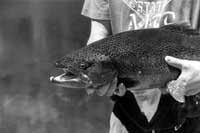
Do not allow to establish the most appropriate way to confront biological invaders, that is, take measures to prevent invaders from moving from one side to another. The International Maritime Organization, for example, has recommended that freighters change ballast water on the high seas. Due to the large differences between this medium and freshwater, the species from the sea will not adapt to the target ecosystem nor will invasions occur. On the other hand, motorized boat owners have been asked to properly check the vessels before moving.
One option when invasion is a reality is the use of pesticides and herbicides. However, most are toxic and dangerous, so they are only used in very specific cases.
Sometimes plants and animals can be removed from the ecosystem, collecting them one by one. Other times controlled fires or flooding are used against invasions. Biological control is also common.
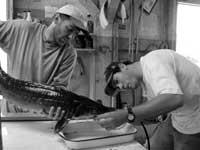
As mentioned at the beginning of the article, one of the factors to prevent the spread of invasive species are natural predators. To carry out biological control, predators of invasive species can be integrated into the invaded ecosystem, that is, a strange species can be eliminated with another alien. The alien predator does not affect as much as the invasive species to the ecosystem and can restore ecological balance. However, this path generates many debates. Environmentalists and conservation groups ask if biological control is safe, rational and necessary, as they distrust. Despite the success of several projects, biological control is not an anti-invasion panacea and if not used properly can cause more harm than benefits.
Some invaders
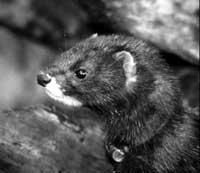
Zebra mussel
Zebra mussel ( Dreissena polymorpha) is a mollusc that flows in fresh water, but also adapts to saltwater. It comes from the Black Sea and Caspian and is not edible. Due to the river navigation of the area, the XIX. It spread throughout Europe in the 20th century; for the 20th century, besides in Europe, it was in North America.
In many places the zebra mussel is an epidemic. The larvae of this mussel have a great capacity for proliferation and displacement. They grow fast and are able to reproduce every month. Want a data? In the Great Lakes area of the United States in 1988 there were 200 mussels per square meter, compared to 4,500 in 1989.
Serious problems occur in areas colonized by the zebra mussel. In fact, as phytoplankton eats, native species become inedible and cover the substratum until altering the ecosystem itself.
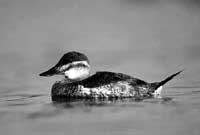
The rusty duck
is a kind of duck from North America. He joined Europe from Great Britain in private bird collections and has already spread across the continent. The main victim of rusty ducks is the duck, which is in danger of extinction. The rusty duck is often mixed with the duck duck females, causing a genetic loss.
American mink
American mink has become the main threat of European mink, as it often colonizes its habitat. American minks are brought to Europe to take advantage of their skin to do business. Due to its difficult control, it has escaped several times from the nurseries and has realized the rivers of the area. It is stronger than the European mink or turon and is being discarded.

Mink is a medium-sized mammal that spends most of its life in the water. It prefers rivers, ponds and streams. There he lives, feeds and reproduces.
It is a fast animal both in swimming and under water. It prefers shallow waters, wide and above all currents. In addition, she loves the banks with abundant vegetation. Normally select central and lower parts of the river channels to live.
It is carnivorous and eats rodents, birds, amphibians and some fish. The mink lives at night and alone. You have 4 or 5 children per season. Newborns, although they spend the first months together, after the summer each starts their way.
European
mink European mink XIX Until the mid-twentieth century. It is at this time that the decline of the European mink begins, both in terms of population and territory. Currently, only some isolated groups remain in Russia and the Iberian Peninsula. Along with the colonization of the American mink, the main causes of the decline of the water mink are the loss of the place of residence and the degradation of the territory by the deposition and / or human pollution. Right now, the European mink is in danger of extinction.
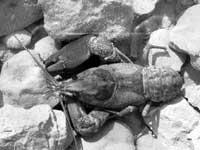
The American crab The
American crab is an animal of good appearance, of great yew and reddish, while the European crab is much smaller and less spectacular, yes, of excellent taste next to the other. American XX. It reached the European rivers in the second half of the 20th century, but it did not come only with a fungus. This mushroom does not harm the American crab, while the European sick and kills.
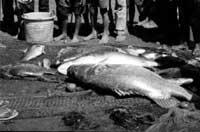
The Nile perch
on Lake Victoria in Kenya is very significant. There lived in 1950 more than 200 species of endemic fish. But in 1958, the Nile perch, a large predator inhabiting the Nile River, was transferred to the lagoon and in 1962 and 63 the population increased. A year later, the Nile perch was found in Uganda, and by 1970 it was completely located in Kenya. Biological effects of invasion: The endemic fish species of Laguna Victoria have practically disappeared and has evolved to the point that the food network is unrecognizable. 200 species have disappeared.
Other conclusions: on the one hand, the Nile perch is an excellent source of food for the inhabitants of the environment of Lake Victoria and, on the other, is the basis of a small industry in rapid development. Therefore, what has been a disaster for the original fauna has become an important economic asset for its inhabitants.
Caulerpa taxifolia
Caulerpa taxifolia began its Mediterranean history in a trash can in the oceanographic museum of Monaco. The Monaco Museum aquarium did not work too hard to clean the containers. The algae were extracted from the root and thrown directly from the window into the sea. No one thought that a tropical seaweed could survive in the Mediterranean!
But C . taxifolia is able to survive in the Mediterranean and invade the Mediterranean! In 1992, between March and October, C . the area occupied by the taxifolia went from 50 to 180 hectares. The area gained by the algae in 1994 was 600 hectares, 730 in 1995 and 1,500 in 1998. Today it has invaded 6,000 hectares on the Mediterranean coast (Spain, France, Monaco, Italy, Croatia). The worst thing is that the place of residence of this algae is not limited to the Mediterranean. And it has recently been discovered on the coast of California. Faced with this expansion, scientists from the Mediterranean peoples have joined the C. taxifolia is a risk of destruction of biological balance.
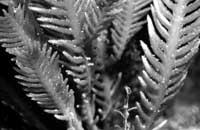
C. taxifolia has a peculiar and simple anatomy. It is the only cell with many cores. It is not easy to disappear, as the plant dies from one end and the other grows. Some mutations have turned the small tropical plant into an invasive 80 centimeters in the Mediterranean. To expand, for example, it is enough for the marine currents or a ship to unconsciously destroy a cutting.
It is undemanding with the environment and adapts to all types of substrates. Whether rock, sand or wild, it prefers solid substrates. Moreover, it can also be fixed in clean or contaminated places like ports. Luminosity and temperature changes are also not an obstacle to its expansion. Unlike the Australian variety, the Mediterranean supports cold temperatures well.
Temperature changes have a lot to do with the development of this algae, but that is not why it dies. You can spend 3 months in water at 10 degrees. At the end of summer and autumn it increases by two centimeters per day.
It also meets the last essential requirement for its easy expansion: it has no predators and emits a toxic substance to chase away fish.
The diversity of fauna and flora of the Mediterranean Sea has decreased considerably. Others, C . the 'carpet' that generates the taxifolia, just to cover, destroys all sustainable vegetation. Being toxic, the fauna directly related to this vegetation is having direct consequences, since the animals cannot replace their usual food with this new algae. Some species are disappearing and others multiply. Fishermen have also begun to suffer the consequences of algae, as algae fragments emerging from the sea currents destroy the nets of fishermen.
A boat that traveled through the West Atlantic, around 1982, took the invertebrate Mnemiopsis leidyi to the Black Sea.
Although they initially seem harmless, smaller species can cause a huge disaster. An animal similar to a translucent Medusa, which at the age of ten completely destroyed the fishing of the Black Sea. In 1984 they went from fishing 204,000 tons of anchovy, 24,600 tons of Roma sardines and 4,000 tons of verdel, not to fish 200 tons, 12,000 tons and no verdel, respectively. Other
species that have spread without measure are the starfish Asterias amurensis and
They are the crab Carcinus maenas. Both have entered the coasts of Tasmania and Australia. The star of the sea was first seen in 1986 and today there are millions of individuals. The
crab, for its part, entered in 1900 and is causing a terrible disaster in molluscs, especially in oysters and mussel nurseries. In order to avoid the reproduction of these two species, the introduction of raptors is being proposed.
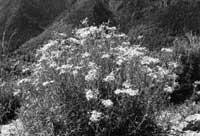
Senecio inaequidens The flowers
of this plant are very similar to daisies, although they are yellow rather than white. Europe XIX. It came in the 19th century due to the cotton trade. It was identified in Hannover in 1889 and by 1950 it was in southern Europe. It adapts perfectly to extreme environmental conditions, grows quickly, has many flowers and being long-haired the wind transports it with ease. It has all the necessary features to be invading. Despite its enormous extent, for the moment it has not caused any significant damage, but it can be due to its difficult biological control.
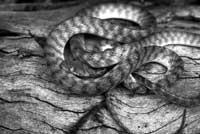
The Boiga irregularis snake
on the island Guam of Micronesia is difficult to see. In fact, the Boigas irregularis snake from Papua New Guinea has virtually disappeared. The snake accidentally arrived on the island in the 20th century. In the middle of the 20th century. Fifteen years later there were a million Boigas irregularis suge in Guam. With its proliferation, the bird population began to descend noticeably. Currently there are only 3 species of birds on the island of Guam.
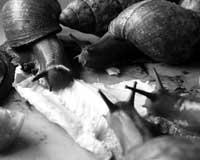
The cartoonist Achatina lived
the countless snail species of the genus Partula, on the island Moorea of Polynesia. In 1967 a huge African snail was introduced for human consumption, the Achatina snail, fast to reproduce and of excellent flavor. In a short time there were millions of Achatina snails on the island. Being a herbivore, he began to eat trees, grass and crops. To solve the problem, in 1977 Moore was taken to the carnivorous snails Euglandina pink of Florida. He started working, but instead of eating Achatina snails, he ate Parulas snails. Currently only the Snail Shells can be seen in reserves and zoos, and the Florida snail continues to destroy the tranquil Moore ecosystem.
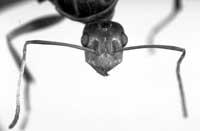
The crazy ant The
crazy ant, Anoplolepis gracilipes, is a 4 millimeter insect. Its origin dates back to tropical Africa, but it extends all over the world and has caused great catastrophes, especially in the islands. On the island of Christmas, for example, all land crabs disappeared in 18 months, about 3 million. Crabs played an important role in the island's ecosystem as they collected grass from the earth.
Published in D2 section of Deia.
Buletina
Bidali zure helbide elektronikoa eta jaso asteroko buletina zure sarrera-ontzian











